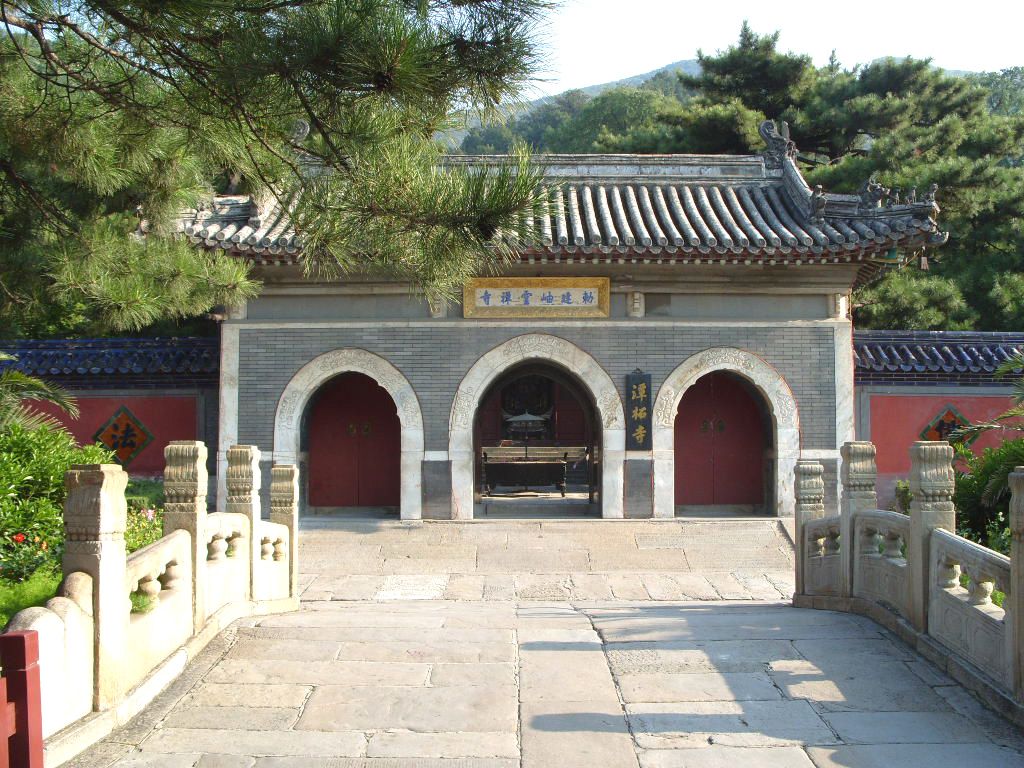
潭柘寺始建于西晋永嘉元年(公元307年),寺院初名“嘉福寺”,清代康熙皇帝赐名为“岫云寺”,但因寺后有龙潭,山上有柘树,故民间一直称为“潭柘寺”。岫云禅寺,通称潭柘寺,位于北京市门头沟区潭柘山山腰,在108國道上。它始建于西晋年间(265年-420年),当时叫嘉福寺,是北京市最早的一座寺庙,民间曾有“先有潭柘寺,后有北京城”(应该是“先有潭柘,后有幽州”)之说。 潭柘寺西晋始建时称嘉福寺,在唐代叫龙泉寺,金代重修之后称大万寿寺,元、明、清三代都有修建。清康熙重建,赐名岫云禅寺。寺名虽经历代改名,但潭柘寺这一俗称一直沿袭下来,潭柘的名字源于寺后有龙潭,山上有柘树。
In Beijing gibt es eine für das Alter des Tempels Tanzhesi bezeichnete Redensart: "Zuerst entstand der Tanzhesi, hernach die Stadt Beijing."
Der Tanzhe-Tempel stammt aus der Jin-Dynastie (265-429). Ursprünglich hieß er Jiafu-Tempel. Der Name Tanzhe-Tempel kommt vom Longtan (Drachenteich), der sich hinter dem Tempel befindet, und von der in dieser Gegend wachsenden Baumart Zheshu (Cudrania tricuspidata). Zu verschiedenen Zeiten mehrmals umbenannt, blieb der Name "Tanzhe-Tempel" doch am gebräuchlichsten, während die anderen Bezeichnungen allmählich in Vergessenheit gerieten.
Der Tanzhe-Tempel liegt in einer schönen Berggegend im Bezirk Mentougou. Kommt man an das Tor des Tempels, fallen einem zunächst mächtige Kiefern auf. Man sagt, dass diese eindrucksvollen Kiefern schon einige hundert Jahre alt seien.
Die kompakt und streng geordnete Anlage des Tempels zeigt alle Merkmale der Tempelbauten aus der Ming- und der Qing-Zeit. Haupt- und Nebenhallen fügen sich zu zahlreichen symmetrisch angelegten Höfen. Die Tempelkomplex ist in drei parallele Achsen gegliedert. Entlang der mittleren Achse steht eine Reihe von erhaben wirkenden kleineren und größeren Bauten: der vordere Pailou (Torbogen), das Tempeltor, die Tianwang-Halle (Halle der Himmlischen Könige), die Mahavira-Halle (Schakjamuni-Halle), die Sansheng-Halle (Halle der Drei Weisen) und der hintere Vairocana-Pavillon. Im mittleren Hof, östlich der Mahavira-Halle, steht ein fast 40 m hoher Ginkgobaum, dessen Umfang so groß ist, dass es mehrerer Menschen bedarf, ihn zu umfassen. Obwohl der Überlieferung nach schon zur Zeit der Liao-Dynastie (916-1124) gepflanzt, hat er immer noch eine üppige dunkelgrüne Krone. Der Qing-Kaiser Qianlong verlieh ihm den Namen "Kaiserbaum". Westlich der Halle steht ein zweiter Ginkgo, der später als Gegenstück gepflanzt wurde. Vom Vairocana-Pavillon aus kann man die ganze Tempelanlage und die umliegenden Berge übersehen.
潭柘寺(たんしゃじ、英語: tangzhesi)は、中華人民共和国北京市の西郊外の門頭溝区にあるお寺である。潭柘山の麓にあり、北京市街地から約30キロの場所にある。非常に歴史あるお寺であり、晋代(265年-420年)に建立されたと言われている。もともと嘉福寺と呼ばれていたが、清の康熙帝に岫雲寺と名付けられた。康熙帝は自ら岫雲寺と書いた額を贈ったとされる。しかし寺の裏側には龍の湿地帯(潭)があり、山の上には柘の木があったことから、民間では常に潭柘寺と呼ばれ、それが定着した[1]。
古刹であるため、古くから多くの有名人がこの地を訪れた。特に清の康熙帝と乾隆帝は何度もこの地を訪れた。このため、皇家のお寺にもなった。1929年にはわざわざ蔣介石が参拝しに来たほどである。中華人民共和国成立後は1956年に朱徳が訪問したことがある。ただし文革時代に貴重なものが破壊され、流失した。1968年に一度閉鎖されたものの、1978年より復旧作業がスタートし、1980年7月に再び一般開放された。
潭柘寺は北に座した南向きの建物で、東、真ん中、西の三つに分かれている。真ん中の建物は山門、天王門、大雄宝殿、毘盧閣などで、東は方丈院、延清閣、行宮院、万寿宮、太后宮で、西は戒台、観音殿などになる。また乾隆帝が植えたとされる帝王樹」、「配王樹」のイチョウの木は樹齢1000年を超えると言われ[2]、見所の一つである。その他、山頂にある毘盧閣からは全体を眺めることができ、山全体の紅葉なども見ることができる[3]。
The Tanzhe Temple (Chinese: 潭柘寺; pinyin: Tán Zhè Sì; lit. 'Temple of Pool and Zhe Tree') is a Buddhist temple situated in the Western Hills, a mountainous area in western Beijing. At one time, it was one of the most important temples in the nation. The temple is located near China National Highway 108 in the Mentougou District of Beijing.
Built in the Jin Dynasty (265–420), it has an age of around 1,700 years. Tanzhe Temple is one of the oldest temples in Beijing. The area of the entire temple is 100 mu (6.8 hectares), and its arrangement of halls is akin to that found in the Ming and Qing dynasties.
Le temple Tanzhe (chinois : 潭柘寺 ; pinyin : ) est un temple bouddhiste situé dans les Collines de l'Ouest, une région montagneuse située à l'ouest de Pékin. À une époque, c'était l'un des temples les plus importants du pays. Le temple est situé près de la route nationale chinoise 108 dans le district de Mentougou, à Pékin.
Construit sous la dynastie Jin (265–420), il a environ 1 700 ans et est l'un des plus anciens temples de Pékin. La superficie totale du temple est de 100 mu (6,8 hectares) et l'agencement des salles qui le compose ressemble à ceux des bâtiments construits sous les dynasties Ming et Qing .
Таньчжэ (кит. 潭柘寺) — крупный буддийский храмовый комплекс на западе от Пекина по 108 трассе в Западных Горах ( Сишань ). Это один из самых известных храмов Китая, построенный ещё в эпоху Цзинь ( 265-420 ). Название происходит от горы Таньчжэшань, которая своим названием обязана расположенному поблизости Драконьему пруду - Лунтань и растущим вокруг него деревьям чжэ ( Кудрания триостренная )




 Architecture
Architecture
 History
History



